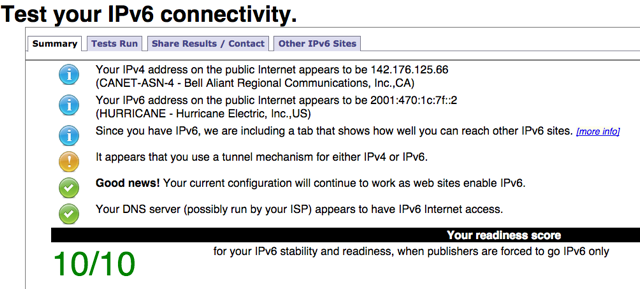Thanks to a nudge from my friend Dave Cairns, I’ve dipped my toe into the waters of IPv6, and I’m noting what I did here for future reference.
Enabled ICMP on my Bell Aliant-provided Actiontec R1000H router; this is done from the Firewall tab by enabling WAN PING mode.
Visited to https://www.tunnelbroker.net/ and registered for a free Tunnelbroker account.
Clicked Create Regular Tunnel in the left sidebar.
As IPv4 Endpoint (Your side), I entered the IP address that Bell Aliant assigned to my Actiontec R1000H router (it appears as “Modem IP Address” on the main status screen).
Selected the Toronto tunnel server and clicked Create Tunnel.
From my MacBook Air’s Terminal app:
sudo ifconfig gif0 tunnel 192.168.2.12 216.66.38.58 sudo ifconfig gif0 inet6 2001:470:1c:7f::2 2001:470:1c:7f::1 prefixlen 128 sudo route -n add -inet6 default 2001:470:1c:7f::1
The 192.168.2.12 IP address above is the LAN IP address of my MacBook Air.
In the MacBook Air’s System Preferences under Network | Wi-Fi | DNS, added IPv6 nameservers from the Tunnelbroker tunnel information page (2001:470:20::2 and 74.82.42.42), in addition to the IPv4 ones from Google that were already there.
That’s it.
At this point I could then visit http://www.test-ipv6.com/ and see the following:

And, from the Mac OS X command line:
# ping6 ns.upei.ca PING6(56=40+8+8 bytes) 2001:470:1c:7f::2 --> 2001:410:e000:903:1::1 16 bytes from 2001:410:e000:903:1::1, icmp_seq=0 hlim=56 time=77.641 ms 16 bytes from 2001:410:e000:903:1::1, icmp_seq=1 hlim=56 time=98.467 ms 16 bytes from 2001:410:e000:903:1::1, icmp_seq=2 hlim=56 time=65.694 ms 16 bytes from 2001:410:e000:903:1::1, icmp_seq=3 hlim=56 time=71.714 ms
I’m fairly certain this is all going to fall to pieces when my DHCP lease from Bell Aliant expires; by that time, though, I hope that Dave has read this far and is ready for the next dose of help.
 I am
I am
Comments
Want to mention that I also
Want to mention that I also use Tunnelbroker with IPv6 and FibreOp in Charlottetown. I use an rt-n56u router with Padavan firmware in place of the Actiontec. It has IPv6 tunneling capabilities to directly connect and distribute IPv6 address to your home network. So anything that can dual-stack will have both IPv4 and IPv6 addresses. It can also update its address to Tunnelbroker using Dyndns!
Well done Peter! You now
Well done Peter!
You now have 64bits of address space at your disposal which is amazing considering that the current IPV4 address space is 32bits. Just to illustrate that point, a 32bit network contains addressing for approximately four billion devices. A 64bit allocation gives you 18,446,744,073,709,551,616 (= more than eighteen quintillion) ip addresses.
So.. next steps:
To prevent your link from going away need a way to automatically update your information at Hurricane Electric (HE). In my case, HE is supported as one of the DDNS (dynamic dns) options for my router that uses tomato firmware. It is also possible to create a script to do this on the MacBook. You will need your Tunnelbroker ID (not username), Tunnel ID, and Update Key to plug into the script/URL.
I would also suggest that you go through the tutorials and certification on Hurricane Electric’s site if you would like to learn more about IPV6.
You currently have your tunnel landing on your MacBook so anything else that you would like to use with IPV6 needs to see that machine as a router/gateway. Alternately you could move the tunnel endpoint closer to your ISP’s demark point.
Ideally it would be nice to place the endpoint on the ActionTec router but unfortunately this is not supported.
My solution for this was to replace the R1000H with a Ubiquiti Edgerouter Lite as a way to learn more about IP multicast (which is what FibreOP uses for the TV service) and to re-acquaint myself with VLANS.
I see from another comment, that someone uses an ASUS RT-N56U router running third party firmware to replace their ActionTec and an ASUS RT-N66U, could also pressed into service with asus-merlin firmware.
I wanted to add that there
I wanted to add that there was no particular attachment to the RT-N56U model. I used that one because it was the recommended model on the Digital Home forums for FibreOp.
The RT-N56U is a good router,
The RT-N56U is a good router, I use the RT-N66U routers in a couple of places in my network.
I thought that I'd reply to this thread (again) and see if anyone else is using IPv6 these days...
Add new comment